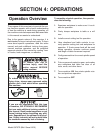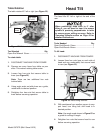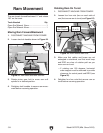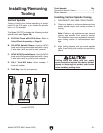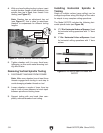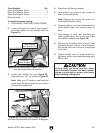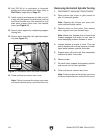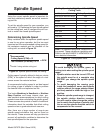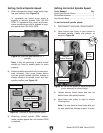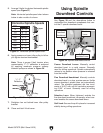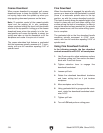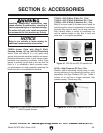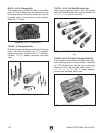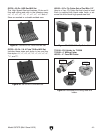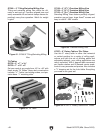
Model G0757Z (Mfd. Since 02/15)
-35-
Spindle Speed
Using the correct spindle speed is important for
safe and satisfactory results, as well as maximiz-
ing tool life.
To set the spindle speed for your operation, you
will need to: (1) Determine the best spindle speed
for the cutting task, and (2) configure the mill con-
trols to match the closest spindle speed.
Determining Spindle Speed
Many variables affect the optimum spindle speed
to use for any given operation, but the two most
important are the recommended cutting speed for
the workpiece material and the diameter of the
cutting tool, as noted in Figure 32:
Recommended
Cutting Speed (FPM) x 12
Tool Diameter (in inches) x 3.14
= RPM
*
*
Double if using carbide cutting tool
Figure 32. Spindle speed formula for milling.
Cutting speed, typically defined in feet per minute
(FPM), is the speed at which the edge of a tool
moves across the material surface.
A recommended cutting speed is an ideal speed
for cutting a type of material in order to produce
the desired finish and optimize tool life.
The books Machinery’s Handbook or Machine
Shop Practice, and some internet sites, pro-
vide excellent recommendations for which cutting
speeds to use when calculating the spindle speed.
These sources also provide a wealth of additional
information about the variables that affect cutting
speed and are a good educational resource.
Also, there are a large number of easy-to-use
spindle speed calculators that can be found on
the internet. These sources will help you take into
account all applicable variables to determine the
best spindle speed for the operation.
Figure 33. Cutting speed table.
Cutting Speeds for High Speed Steel (HSS)
Cutting Tools
Workpiece Material Cutting Speed (sfm)
Aluminum & Aluminum Alloys 300
Brass & Bronze 150
Copper 100
Cast Iron, soft 80
Cast Iron, hard 50
Mild Steel 90
Cast Steel 80
Alloy Steel, hard 40
Tool Steel 50
Stainless Steel 60
Titanium 50
Plastics 300-800
Wood 300-500
Note:
For carbide cutting tools, double the cut-
ting speed. These values are a guideline only.
Refer to the MACHINERY'S HANDBOOK for
more detailed information.
To avoid damaging the spindle, gears, or
cutting tools when setting the spindle speed
range:
• Spindle rotation must be turned OFF and
the spindle must be at a complete stop
BEFORE you change the spindle speed
range.
• To avoid damaging the moving parts
inside the headstock, never start spindle
rotation without the range selector detent
pin firmly seated in either the high or low
position.
• When the spindle speed range is changed,
the spindle rotation direction reverses.
You will need to either change the cutting
tool to match the direction of spindle rota-
tion or use the spindle direction switch to
compensate for the reversal.



